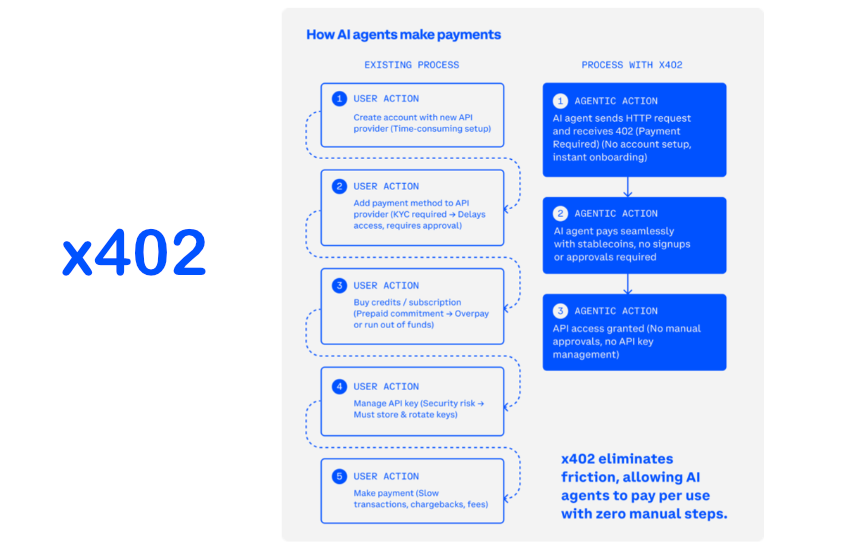
In today’s fast-paced digital world, making payments online often feels like jumping through hoops. You sign up for accounts, enter credit card details, or wrestle with clunky apps. But what if payments could happen as smoothly as loading a webpage? Enter the x402 protocol. This innovative open standard, built on the long-forgotten HTTP 402 “Payment Required” status code, lets AI agents, apps, and users pay instantly for digital resources without all the hassle. Developers love it because it works seamlessly with existing web tech, and everyday folks benefit from quicker, cheaper transactions. As we dive deeper, you’ll see how x402 is reshaping the internet economy, one simple request at a time.
What Is the x402 Protocol?
At its core, the x402 protocol simplifies online payments by embedding them directly into the web’s language: HTTP. Imagine you’re trying to access a premium article or run an AI query. Instead of a login wall, the server sends back a 402 response—think of it like a polite “pay up first” note. Then, you send the payment via a blockchain transaction, often in stablecoins for reliability. After that, the server checks the blockchain and grants access. No middlemen, no subscriptions, just direct value exchange.
This approach stands out because it treats payments like any other web interaction. For instance, if an AI agent needs data from an API, it can pay on the spot without human intervention. Consequently, x402 opens doors for machine-to-machine economies where bots trade services autonomously. Moreover, since it’s chain-agnostic, it supports various blockchains, making it flexible for global use.
But why now? Traditional payment systems, like Stripe or PayPal, excel at big purchases but falter on tiny ones—those micropayments under a dollar that add up in the AI era. x402 fixes this by slashing fees to zero for users and merchants in many cases. As a result, creators can charge for single API calls or webpage views without scaring off customers with overhead costs.
The Origins and Evolution of x402
Coinbase sparked the x402 protocol back in May 2025, reviving the dusty HTTP 402 code from the 1990s. Engineers at Coinbase saw the rise of AI agents—smart programs that act independently—and realized payments needed an upgrade. Why force these agents to mimic humans with forms and verifications? Instead, x402 lets them pay natively over HTTP.
Early adopters, including Cloudflare, jumped in quickly. In October 2025, Cloudflare partnered with Coinbase to launch the x402 Foundation, a nonprofit dedicated to its growth. This group pushes for open standards, ensuring no single company controls the protocol. For example, they released tools for deferred payments, where settlements happen later—perfect for high-volume AI trades.
Since then, activity has exploded. Data shows a 10,000% surge in x402 transactions in late October 2025, hitting nearly 500,000 in one week. Developers launched “x402 tokens,” niche assets tied to the protocol, pushing their market cap to $180 million overnight. This momentum proves x402 isn’t just theory; it’s gaining real traction in the wild.
Furthermore, the protocol’s open-source nature on GitHub invites contributions. Coders add features like better error handling or support for more chains, fostering a community-driven evolution. All in all, x402 started as a Coinbase experiment but quickly became a collaborative force.
How the x402 Protocol Works: A Step-by-Step Breakdown
Let’s break it down simply. Suppose you want to access a paid AI image generator via API. Here’s the flow:
First, your client—be it a browser or an AI script—sends a standard HTTP GET request to the server.
Second, if payment is needed, the server responds with HTTP 402. It includes headers detailing the cost (say, $0.01 in USDC), the recipient’s wallet address, and supported chains like Base or Ethereum. No login required; everything’s in plain sight.
Third, your client crafts a blockchain transaction. It signs the payment with your wallet and broadcasts it. Tools like x402 libraries handle the crypto magic behind the scenes.
Fourth, the client retries the original request, attaching a proof of payment—often a transaction ID or signed receipt.
Finally, the server verifies the transaction on-chain (quickly, thanks to fast networks) and delivers the goods. If something goes wrong, it sends a clear error, and you can retry.
This loop happens in seconds, often invisibly. For developers, adding x402 means dropping in middleware for frameworks like Express.js—one line of code, and you’re set. Clients use JavaScript libraries to parse 402 responses and automate payments.
What makes it robust? Extensibility. The “scheme” field lets you customize settlements—immediate crypto, deferred fiat, or even batched invoices. Additionally, cryptographic signatures prevent fraud, ensuring only valid payments unlock resources.
In practice, this shines for AI agents. An agent querying a weather API pays per call, scaling costs to usage. No flat fees; just fair, granular billing.
Key Features That Set x402 Apart
x402 packs several standout traits. Primarily, its zero-friction design eliminates accounts and OAuth dances. Users pay directly from wallets, merchants receive funds instantly—pure peer-to-peer bliss.
Another highlight: micropayment mastery. Traditional cards charge 2-3% per swipe, killing small deals. x402 leverages blockchains with near-zero gas fees, like Layer 2 solutions, so a 1-cent payment costs pennies to process. Consequently, content creators can monetize snippets without ads or bundles.
Openness reigns supreme. As an HTTP standard, it integrates anywhere—web servers, mobile apps, even IoT devices. The x402 Foundation ensures interoperability; your Python agent pays a Node.js service effortlessly.
Moreover, security comes baked in. Payments use on-chain verification, resistant to chargebacks. Deferred schemes add flexibility for uncertain scenarios, like AI negotiations where final costs vary.
Finally, AI-first thinking. x402 anticipates autonomous agents. With XMTP for chat, agents can haggle prices or bundle services, all settled via 402 flows. This isn’t just payments; it’s economic plumbing for intelligent machines.
Real-World Applications and Early Success Stories
Developers are already putting x402 to work. Take news sites: Publishers like The New York Times could charge per article view. A reader hits a paywall, gets a 402, pays $0.05 in stablecoin, and reads on—no subscription nag.
In AI, it’s transformative. Platforms like Hugging Face use x402 for model inferences. An agent fine-tuning a language model pays per GPU minute, optimizing costs dynamically. One startup reported 300% more API usage after switching, as friction dropped.
Gaming sees gains too. Indie devs charge for in-game assets via x402—buy a skin with crypto, no app store cut. Cloudflare’s edge network accelerates verifications, making it seamless even on mobile.
Beyond that, e-commerce evolves. Flash sales or personalized ads could trigger instant micro-pays. A shopper views a custom recommendation? Pay a cent for the tailoring. This granular model boosts revenue without alienating users.
Early data underscores impact. Coinbase noted x402-powered token launches spiked 266% in value in hours. Meanwhile, Base docs highlight agent builds combining x402 with chat protocols, creating self-sustaining digital economies.
Of course, challenges exist. Not all wallets support it yet, and education lags. However, as libraries proliferate, adoption accelerates. For businesses, the upside is clear: more revenue streams, less overhead.
Challenges and the Road Ahead for x402
No tech is perfect, and x402 faces hurdles. Blockchain volatility once deterred users, but stablecoins mitigate that. Still, verification times vary—Ethereum L1 lags, while Base flies. Solutions like optimistic checks speed things up.
Regulatory scrutiny looms. As micropayments boom, governments eye crypto rails for taxes or AML. The x402 Foundation advocates for compliant designs, like optional KYC for big sums.
Scalability tests the protocol too. A million-agent swarm could clog networks. Deferred payments help, batching settlements off-peak. Additionally, cross-chain bridges expand options without fragmentation.
Looking forward, enhancements beckon. Proposals include fiat on-ramps for non-crypto users and AI-optimized schemes for probabilistic payments—pay after value delivery. Community input via GitHub drives this.
In essence, x402’s path involves iteration. Partnerships with wallets like MetaMask and servers like Vercel will normalize it. By 2026, expect x402 in everyday apps, powering a web where value flows as freely as data.
Why x402 Matters: A New Era of Web Commerce
Ultimately, x402 isn’t just a protocol; it’s a mindset shift. It democratizes monetization, letting small creators compete with giants. Developers build without payment silos, users pay precisely for what they value. In an AI-driven future, where agents outnumber humans online, x402 ensures everyone—machine or person—participates in the economy.
As we have seen, its simplicity belies profound change. Frictionless payments foster innovation, from agent marketplaces to pay-per-pixel art. Moreover, by standardizing on HTTP, x402 future-proofs the web against proprietary traps.
To conclude, embracing x402 means betting on an open, efficient internet. Developers, start experimenting today—grab the GitHub repo and prototype. The protocol awaits, ready to unlock value you didn’t know was there. What will you build with it?

Leave a Reply